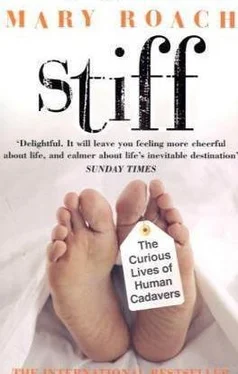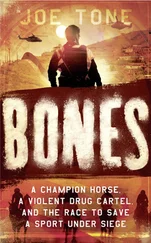I asked Walsh whether any family members had asked to see a copy of the study when it was published. No one had. “We got the impression, quite frankly, that we were giving people more information than they wanted to hear.”
In England and other Commonwealth countries, researchers and anatomy instructors sidestep the possibility of family or public disapproval by using body parts and prosections—the name given to embalmed cadaver segments used in anatomy labs—rather than whole cadavers. England’s antivivisectionists, as animal rights activists are called there, are as outspoken as America’s, and the things that outrage them are more encompassing, and, dare I say it, nonsensical. To give you a taste: In 1916, a group of animal rights activists successfully petitioned the British Undertakers Association on behalf of the horses that pulled their hearses, urging members to stop making the horses wear plumes on their heads.
The British investigators know what butchers have long known: If you want people to feel comfortable about dead bodies, cut them into pieces.
A cow carcass is upsetting; a brisket is dinner. A human leg has no face, no eyes, no hands that once held babies or stroked a lover’s cheek. It’s difficult to associate it with the living person from which it came. The anonymity of body parts facilitates the necessary dissociations of cadaveric research: This is not a person. This is just tissue. It has no feelings, and no one has feelings for it. It’s okay to do things to it which, were it a sentient being, would constitute torture.
But let’s be rational. Why is it okay for someone to guide a table saw through Granddad’s thigh and then pack up the leg for shipment to a lab, where it will be suspended from a hook and impacted with a simulated car bumper, yet not okay to ship him and use him whole? What makes cutting his leg off first any less distasteful or disrespectful? In 1901, the French surgeon René Le Fort devoted a great deal of his time to studying the effects of blunt impact on the bones of the face. Sometimes he severed the heads: “After decapitation, the head was violently thrown against the rounded border of a marble table…,” reads an experiment description from The Maxillo-Facial Works of René Le Fort . Other times he left the heads on: “The entire cadaver was in a dorsal… position with the head hanging back over the table. A violent blow was given with a wooden club on the right upper jaw….” What person who takes offense at the latter could reasonably be comfortable with the former? What, ethically or aesthetically, is the difference?
Furthermore, it’s often desirable, from the standpoint of biomechanical fidelity, to use the entire enchilada. A shoulder mounted on a stand and hit with an impactor doesn’t behave in the same manner, or incur the same injuries, as a shoulder mounted on a torso. When shoulders on stands start getting driver’s licenses, then it will make sense to study them. Even scientific inquiries as seemingly straightforward as How much will a human stomach hold before it bursts ? have gone the extra mile. In 1891, an inquiring German doctor surnamed Key-Aberg undertook a replication of a French study done six years earlier, in which isolated human stomachs were filled to the point of rupture. Key-Aberg’s experiment differed from that of his French predecessor in that he left the stomachs inside their owners. He presumably felt that this better approximated the realities of a hearty meal, for rare indeed is the dinner party attended by freestanding stomachs. To that end, he is said to have made a point of composing his corpses in the sitting position. In this case, our man’s attention to biomechanical correctness proved not to matter. In both cases, according to a 1979 article in The American Journal of Surgery , the stomachs gave out at 4,000 cc’s, or about four quarts. [16] As fans of the eating sections of old Guinness books of world records will surmise, this figure has been surpassed on numerous occasions. Some stomachs, by way of heredity or prolonged daily gourmandism, are roomier than average. Orson Welles’s was one such stomach. According to the owners of Pink’s hot dog stand in L.A., the voluminous director once sat down and finished off eighteen franks. The all-time record holder would appear to be a twenty-three-year-old London fashion model whose case was described in the April 1985 Lancet . At what turned out to be her last meal, the young woman managed to put away nineteen pounds of food: one pound of liver, two pounds of kidney, a half pound of steak, one pound of cheese, two eggs, two thick slices of bread, one cauliflower, ten peaches, four pears, two apples, four bananas, two pounds each of plums, carrots, and grapes, and two glasses of milk. Whereupon her stomach blew and she died. (The human gastrointestinal tract is home to trillions of bacteria, which, should they escape the confines of their stinky, labyrinthine home, create a massive and often fatal systemic infection.) Runner-up goes to a thirty-one-year-old Florida psychologist who was found collapsed in her kitchen. The Dade County medical examiner’s report itemized the fatal last meal: “8700 cc of poorly masticated, undigested hot dogs, broccoli and cereal suspended in a green liquid that contained numerous small bubbles.” The green liquid remains a mystery, as does the apparent widespread appeal of hot dogs among modern-day gorgers (from Salon.com).
Many times, of course, a researcher doesn’t need a whole body, just a piece of it. Orthopedic surgeons developing new techniques or new replacement joints use limbs instead of whole cadavers. Ditto product safety researchers. You do not need an entire dead body to find out, say, what happens to a finger when you close a particular brand of power window on it. You need some fingers. You do not need an entire body to see whether softer baseballs cause less damage to Little Leaguers’ eyes.
You need some eyes, mounted in clear plastic simulated eye sockets so that high-speed video cameras can document exactly what is happening when the baseballs hit them. [17] This was a subject of heated debate in ophthalmology corners. Some felt that if you made baseballs softer, they would deform on impact and penetrate more deeply into the socket, causing more damage, not less. A study done by researchers at the Vision Performance and Safety Service at Tufts University School of Medicine showed that softer balls did indeed penetrate more deeply, but they didn’t cause more damage. That would have been tough to do, for the harder balls ruptured the eye “from the limbus to the optic nerve with almost total extrusion of the intraocular contents.” Let us hope that the manufacturers of amateur sports equipment have read the March 1999 Archives of Ophthalmology and adjusted the hardness of their baseballs accordingly. Either way, eye protection for Little Leaguers is a swell idea.
Here’s the thing: No one really wants to work with whole cadavers.
Unless researchers really need to, they won’t. Rather than use whole bodies to simulate swimmers in a test of a safety cage for outboard motor propellers, Tyler Kress, who runs the Sports Biomechanics Lab at the University of Tennessee’s Engineering Institute for Trauma and Injury Prevention, went to the trouble of tracking down artificial ball-and-socket hip joints and gluing them to cadaver legs with surgical cement and then gluing the resulting cadaver-leg-and-hip-joint hybrid to a crash test dummy torso.
Kress says it wasn’t fear of public reprisal that led him to do this, but practicality. “A leg,” he told me, “is so much easier to work with and handle.” Parts are easier to lift and maneuver. They take up less space in the freezer. Kress has worked with just about all of them: heads, spines, shins, hands, fingers. “Legs, mostly,” he says. He spent last summer looking at the biomechanics of twisted and broken ankles. This summer he and his colleagues are running instrumented leg-drop tests to look at the sorts of injuries that accompany vertical drops, such as befall mountain bikers and snowboarders. “I would challenge you to find anybody that’s broken more legs than we have.”
Читать дальше












